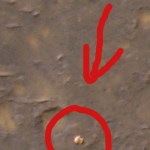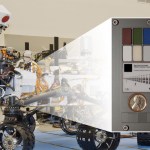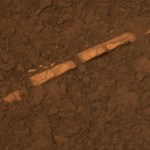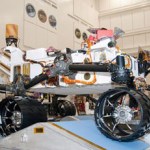Mars
Curiosity landed on Mars last night (I assume you were watching). Well, the High Resolution Imaging Science Experiment on the Mars Reconnaissance Orbiter managed to take a picture of Curiosity with its parachute! This is so cool. Look:
NASA's Curiosity rover and its parachute were spotted by NASA's Mars Reconnaissance Orbiter as Curiosity descended to the surface on Aug. 5 PDT (Aug. 6 EDT). Image Credit: NASA/JPL-Caltech/Univ. of Arizona
How cool is that???? More details here form NASA.
You can watch along with NASA and see briefings and stuff on Curiosity Cam. The Exploratorium also has a page with a web case and various videos.
In case you haven't seen the Seven Minutes of Terror video, here it is:
Updates and a countdown clock will be found here on the NASA site.
This just in:
Curiosity Closes in on its New 'Home'
Sat, 04 Aug 2012 06:20:24 PM CDT
With Mars looming ever larger in front of it, NASA's Mars Science Laboratory spacecraft and its Curiosity rover are in the final stages of preparing for entry, descent and landing on the Red Planet at 10:31 p.m. PDT Aug. 5 (1:31 a.m. EDT Aug. 6). Curiosity remains in good health with all systems operating as expected. Today, the flight team uplinked and confirmed commands to make minor corrections to the spacecraft's navigation reference point parameters. This afternoon, as part of the onboard sequence of…
Caption from NASA: "This artist's scoreboard displays a fictional game between Mars and Earth, with Mars in the lead. It refers to the success rate of sending missions to Mars, both as orbiters and landers. Of the previous 39 missions targeted for Mars from around the world, 15 have been successes and 24 failures. For baseball fans, that's a batting average of .385."
NASA acknowledges the fact that most missions to Mars fail. The rocket goes off course or crashes, or the device lands broken, or works for a while then stops.
According to the latest press release, which has some interesting…
On August 5th, NASA will attempt to do what may be the dumbest thing they ever did.
Or, possibly, the most brilliant thing they ever did. Hard to say.
Perhaps you've heard about the Seven Minutes of Terror. This pertains to the process of landing the robot Curiosity on Mars. There are several steps and most of the steps have the following characteristics:
1) It won't work if the previous step doesn't happen just right;
2) It really can't work anyway; and
3) The outcome of any given step is very likely to screw up the next step.
A kind of cycle of potential failure. Some of the steps…
... well, not really, but ...
No matter how interesting the big expensive science NASA does is, or how important the work is to understanding our planet and solar system or figuring out important problems, nothing is as cool as seeing your own house on a satellite photograph, as it were:
The High Resolution Imaging Science Experiment (HiRISE) camera on NASA's Mars Reconnaissance Orbiter recorded a scene on Jan. 29, 2012, that includes the first color image from orbit showing the three-petal lander of NASA's Mars Exploration Rover Spirit mission. Spirit drove off that lander platform in…
This August, Mars Science Robot Curiosity will land on the surface of the Angry Red Planet equipped with a Penny to tell how big things are.
The camera at the end of the robotic arm on NASA's Mars rover Curiosity has its own calibration target, a smartphone-size plaque that looks like an eye chart supplemented with color chips and an attached penny.
When Curiosity lands on Mars in August, researchers will use this calibration target to test performance of the rover's Mars Hand Lens Imager, or MAHLI. MAHLI's close-up inspections of Martian rocks and soil will show details so tiny, the…
Can you imagine driving around on roadless terrain with a four wheel drive vehicle for eight years and not ever changing a tire, getting a tuneup, adjusting the suspension, replacing the hydraulics or brakes, or doing any other service whatsoever on your vehicle? I've actually done that, and I'm here to tell you, you can't do that!
But Mars Exploration Rover Opportunity has, in fact, done it.
Opportunity was tasked to took around on the Martian surface for three months. The Space Robot landed on Mars on January 25th, 2004. During the last eight years, Opportunity has traveled great…
This is very, very cool.
Geologically, there are ways in which minerals move around and get deposited with rock. A common phenomenon is for a crack to form due to cooling of molten rock or an earthquake or something, and then this space gets filled in. Stuff might just fall into it. Liquidizer rock (magma) might intrude into it. Hot gasses containing residue might build up a deposit within it, or liquid water might flow through it leaving behind minerals, which fill the crack. The thing is, geologists have studied these processes and have a pretty good idea of what they are, how they…
Time for some more insult-throwing. And Morgan Griffith is a deserving recipient of just about any insult you might care to throw. As the youtube video is so correctly titled: Climate Zombie Morgan Griffith: Vikings, Mars, And Global Cooling (uploaded by climatebrad, which leads off to the Wonkroom). And indeed, there he is, brain entirely dead, reading out a list of "questions" he has been supplied by some lobbyist, all of which have been answered long ago.
The bit I like is at about 2:00 in, where he says that when he was taught in high school, his text book told him that increasing GHG's…
A newly found, buried deposit of frozen carbon dioxide -- dry ice -- near the south pole of Mars contains about 30 times more carbon dioxide than previously estimated to be frozen near the pole. This map color-codes thickness estimates of the deposit derived and extrapolated from observations by the Shallow Subsurface Radar (SHARAD) instrument on NASA's Mars Reconnaissance Orbiter. The orbiter does not pass directly over the pole, and the thickness estimates for that area (with smoother transitions from color to color) are extrapolations.
Red corresponds to about 600 meters or yards thick;…
A question came up in the comments on the post Mars will pass behind sun, Rover operations affected, and the answer turns out to be very interesting.
The question was, to paraphrase, how often and when are the Earth based Mars rover operators out of radio contact with the Rovers? It turns out it is pretty complicated, so I'll reproduce the answer I got from Guy Webster, our man in NASA:
Opportunity (and Spirit when it's not hibernating), are out of contact most of the time every day. The rovers can communicate both directly with Earth and via relay through Mars Odyssey or Mars…
We live in an age where truth is, if not stranger than fiction, then at least equally strange. Sometimes pop-science books illustrate this point with particular well-researched glee and Packing for Mars: The Curious Science of Life in the Void is such a book.
Where do I begin? It's a true nerd's smorgasbord. It answers all the scatological and emotional questions that kids always imprudently ask astronauts. It acknowledges the humanness of space travel as a venture: that astronauts are people who must eat, pass gas, have sex, take up space, sweat, sleep, fear, and otherwise learn to be…
By Dr. Rosalba Bonaccorsi
Environmental Scientist at the Carl Sagan Center for the Study of Life in the Universe, SETI Institute, and Gail Jacobs
Rosalba, what first sparked your interest in science?
I've always had big dreams -- even as a young girl. As soon as I started to walk, I took an interest in conducting experiments with whatever was available around such as household plants and various chemical compounds. I'm lucky I didn't end up poisoned or otherwise hurt! I remember dismantling alarm clocks. I was so curious!
As a young girl, I was in poor health and as a result spent a lot of…
By Dr. Adrian Brown
Planetary Research Scientist at the Carl Sagan Center for the Study of Life in the Universe, SETI Institute
The last two months have witnessed several extremely important events with respect to future Mars Exploration. The first two revolved around the rover "Spirit." The other two are a new mission to Mars and a possible road for humans to Mars.
"Spirit"
On June 3rd, the Mars Exploration Rover (MER) team published a stunning paper describing how the rover "Spirit," now immobile in the shifting sands of Gusev Crater, detected carbonate minerals in a rock called "Comanche…
... maybe.
Maybe there were vast oceans, and maybe they were occupied by microbes. This, according to reserearch being discussed in Natoial Geographic.
A vast ocean chock-full of microbes may have once covered more than a third of Mars's surface, scientists say.
The new evidence, from an analysis of dried-up Mars river deltas, adds to growing signs the red planet was once wet.
On Earth, river deltas all lie at more or less the same elevation and reflect the current sea level. In fact, by estimating the elevations of ancient deltas, scientists can reconstruct how sea levels have changed over…
Rocks examined by NASA's Spirit Mars Rover hold evidence of a wet, non-acidic ancient environment that may have been favorable for life. Confirming this mineral clue took four years of analysis by several scientists.
An outcrop that Spirit examined in late 2005 revealed high concentrations of carbonate, which originates in wet, near-neutral conditions, but dissolves in acid. The ancient water indicated by this find was not acidic.
NASA's rovers have found other evidence of formerly wet Martian environments. However the data for those environments indicate conditions that may have been acidic…
Or should I say "ice."
The Phoenix Mars Lander seems to be dead in the dust, with its solar panels having suffered severe winter ice damage as shown by photos from the Odyssey Orbiter:
The blue color on the left shows clean, reflective, round solar panels. The blacky-browny image on the right indicates that one of the solar panels is, essentially, gone and the other is yecked up.
More imagery and information about the photos are here.
More information about the Phoenix mission here: Press release by D.C. Agle and Dwayne Brown.
Ah, The Onion. A true repository of snark and snideitude
But as the winter lingered, Spirit began producing thousands of pages of sometimes rambling and dubious data, ranging from complaints that the Martian surface was made up almost entirely of the same basalt, to long-winded rants questioning the exorbitant cost and scientific relevance of the mission.
Project leaders receive data from the Mars rover Spirit.
"Granted, Spirit has been extraordinarily useful to our work," Callas said. "Last week, however, we received three straight days of images of the same rock with the message 'HAPPY NOW…
This oblique view shows geological layers of rock exposed on a mound inside Gale Crater on Mars. Image credit: NASA/JPL-Caltech/University of Arizona/USGS
It is easy to forget how important impact craters are on planetary history on a planet like Earth with dynamic continental movement, wind and water erosion, and a short memory. But we are reminded when we look at the research coming out of Mars.
Gale Crater is about the size of Connecticut, and within the crater is a huge mound, several thousand meters high, which expose a time-deep sequence of layers demonstrating dramatic changes in…










